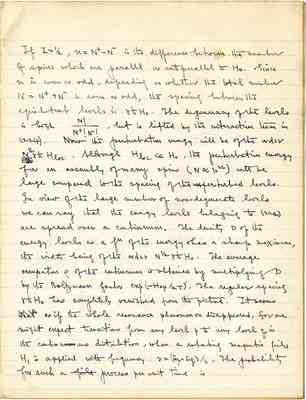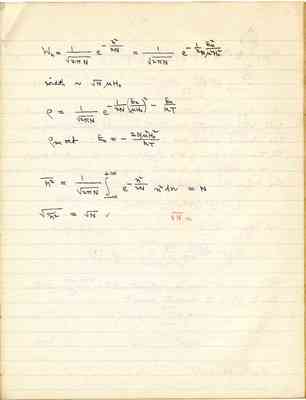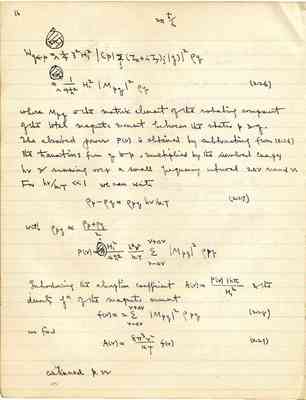Pages
12
H₀+H₁ and the thermal radiation field. Every nucleus, however, also experiences the field produced by the magnetic moments of its neighbors. If this dipole-dipole interaction is taken into account, the Hamiltonian [f-an] assembly of spins becomes
The sum over j in the right hand term represents the internal or local field at the ith nucleus; is the radius vector connecting the ith & the jth spin. The problem connected with (2.24) is [she?] of an extreme complexity. It is the equation of motion for N particles, where N is of the order of Avogadro number. The local field will, at any time, be of the order of few [aersted?]. It is mainly determined by the nearest neighbors, since the magnitude of a dipole field decreases as the inverse cube of the distance: where a is the internuclear distance. For two protons, me Å apart, we find Hloc ≈ [lo ousted?].
The energy levels of the unputurbed system, without dipole-diple interaction are
13
If I=1/2, is the difference between the number of spins which are parallel or antiparallel to H₀. Since n is even or odd, depending on whether the total number is even or odd, the spacing between the equidistant levels is γħH₀. The degeneracy of the level in high , but is lifted by the interaction [term?] in (2.24). Now the perturbation energy will be of the N order . Although , the perturbation energy for an assembly of many spins (N ≈ [10?]²²) will be large compared with spacing of the unperturbed levels. In view of the large number of non-degenerate levels we can say that the energy levels belonging to (2.24) are spread over a continuum. The density D of the energy levels as a fn of the energy has a sharp maximum, the width being of the order N1/2γħH₀. The average occupation ρ of the coninuum is obtained by multiplying by the Boltzmann factor exp(-H0pkT). The regular spacing γħH₀ has completely vanished from the picture. It seems that as if the whole resonance phenomenon disappeared, for we might expect transitions from any level p to to any level q in the continuous distribution, when a rotating magnetic field H₁ is applied with frequency ν = ([Ep - Eq?])/h. The probability for such a field process per unit time is
16
where Mpg in the matrix element of the rotating component of the total magnetic moment between the states p & q. The absorbed power P(ν) is obtained by subtracting from (2.26) the transitions from q to p, multiplied by the involved energy hν & running over a small frequency interval 2Δν around ν. For we can write
with
Introducing the absorption coefficient & the density fn of the magnetic moment we find
continued p. 22






